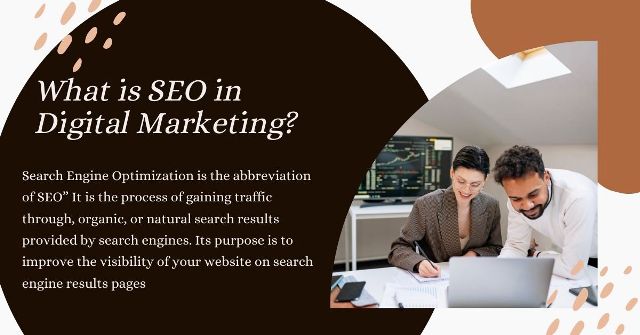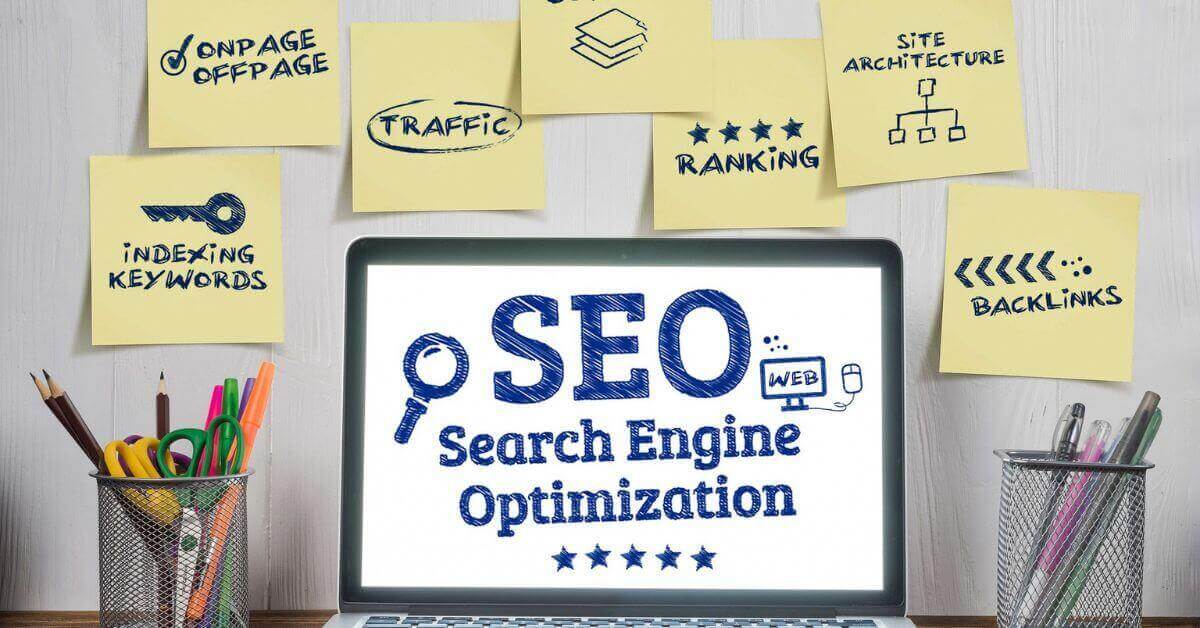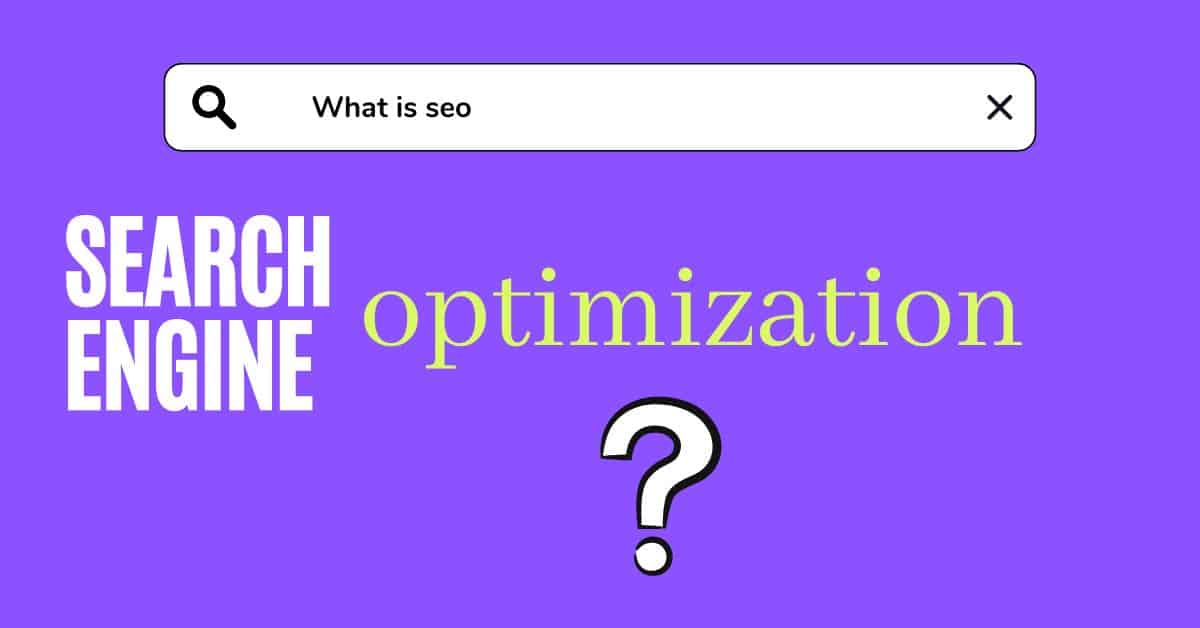What Is SEO In Digital Marketing and How Does It Work Are you new to SEO in digital marketing? First, I need to understand what is SEO in digital marketing and how it works. This will help you plan and continue your digital marketing strategies effectively. Maybe you’ve heard that SEO can help your website receive more traffic and higher ranks, but you’re unsure how it works or where to start. you’ve arrived at the right place – “SEO PORTION”
Let’s read what digital marketers want to know about SEO.
Search Engine Optimization (SEO) is a term used to describe the process of optimizing an (SEO) Let’s begin with what is SEO?:
“Search Engine Optimization is the abbreviation of SEO” It is the process of gaining traffic through, organic, or natural search results provided by search engines. Its purpose is to improve the visibility of your website on search engine results pages.”
SEO includes a wide range of duties, such as:
- Identifying relevant phrases with a high search traffic potential
- Incorporating relevant links from high-quality websites
- Producing valuable, high-quality content optimized for people and search engines.
- Keep tracing the results of organic growth through SEO.
Why Does SEO Matter in Digital Marketing?
Table of Contents
ToggleSEO, or Search Engine Optimization, is an essential part of digital marketing because it helps websites and online businesses improve their visibility in search engine results pages (SERPs) such as Google, Bing, or Yahoo!

The goal of SEO is to optimize a website’s content, structure, and other technical elements to make it easier for search engines to understand and rank it higher for relevant queries. Here are given top 5 points that describe why SEO matters in digital marketing.
- SEO helps websites rank higher in search results, which can lead to more clicks and traffic to the site.
- Websites that appear higher in search results are seen as more authoritative and trustworthy, which can help build a brand reputation.
- Unlike paid advertising, SEO can generate traffic and leads without requiring ongoing investment.
- SEO is a long-term strategy that can yield results for months or years after the initial optimization.
- Also, SEO improves a better user experience and increases engagement.
Overall, SEO is crucial for digital marketing because it can help businesses attract more traffic, improve their brand reputation, and increase conversions.
Why SEO Is Important in Digital Marketing?
Search Engine Optimization, or SEO, is a digital marketing technique that strives to bring targeted traffic to your website by increasing its visibility on web search engines.
The cost of acquiring a new customer has grown exponentially in recent years. As a result, companies are increasingly trying to cut down on their advertising budgets and instead find ways of getting visitors and customers through the Web.
This is where SEO comes into play. It is an indirect way of marketing for websites that do not require major upfront investments but can generate results just as good or even better than traditional advertising techniques.
Now more about SEO fundamentals which work on these three basic pillars –
SEO fundamentals are key to a good digital marketing plan. It makes a website more visible in search results, bringing in more visitors. There are three main parts to SEO: technical, on-page, and off-page.
Technical SEO helps search engines find and list your site. On-page SEO is about making your content great and using the right keywords. Off-page SEO, like getting links and using social media, makes your site more trusted.
- ON–Page Optimization
- OFF–Page Optimization
- Technical Optimization
SEO technique:
Black Hat vs. White Hat
SEO techniques are the process of improving the visibility and ranking of a website or web page (SERPs). White hat SEO refers to practices that are in line with the terms and conditions of the major search engines, while black hat SEO uses techniques that are intended to game the system and improve rankings artificially.
Both white hat and black hat SEO can be effective in achieving higher SERP rankings, but they differ in approach and technique. Black hat SEO is usually much faster in delivering results, but these results may not last long, as they are often achieved through practices that violate search engine guidelines.
White hat SEO takes longer to show results, but the results are more sustainable, as they are achieved through ethical practices that follow search engine guidelines. Which approach is right for you will depend on your goals and your willingness to take risks. If you want to achieve quick results with high risk, black hat SEO may be a good option but we will never recommend doing this.
If you want to take a more sustainable approach with less chance of being penalized by search engines, white hat SEO is the best way to go.
Paid(SEM) vs. Organic Search(SEO): What’s the Difference?
It’s important to know the difference between organic search optimization and paid search.
Position
Paid search results appear at the top of search engine pages. Organic results are below them.
Time
Paid search gives quick results, often in minutes. Organic search results take weeks, months, or years to show up.
ROI
Paid search is easy to measure for return on investment. Google Analytics helps with this. But, paid search ROI can drop over time. Organic search ROI is harder to measure but grows over time, offering a strong return in the long run.
Traffic Potential
About 20% to 30% of searchers click on paid results. But, 70% to 80% click on organic results. So, organic results get more clicks.
What Are the Inner Workings of a Search Engine?
People use search engines to find answers online.
Crawling
Search engines work in three stages: crawling, indexing, and ranking. Web crawlers find new pages and check for updates. They are also called spiders or ‘robots.’
Search engines follow links to explore web pages. When they analyze your homepage, they look for another link to follow.
The next step is indexing
- Indexing decides if crawled content is used. This index is used for ranking.
- Indexed content is stored in a database for later use.
- Content may be excluded if it’s duplicate, poor value, spammy, or hard to crawl.
Organizing (Ranking)
- Ranking is the most important step. It starts after crawling and indexing.
- After crawling and indexing, your site is rated.
- Search engines use over 200 ranking signals. These signals fall under three SEO pillars: technical, on-page, and off-page optimization.
What Are SEO Ranking Factors?
A ranking factor is a part of Google’s algorithms that can be improved to change your site’s position in search results. There are many ranking factors, but some are more important than others.
The title tag and meta description are key ranking factors. Some factors, like title tags and meta descriptions, you can control. Others, like PageRank and link popularity, are up to the search engines. Improving all ranking factors can boost your site’s search ranking, but some are more crucial.
Ranking factors help search engines figure out which content is most relevant to a query. They use these signals to decide which results to show first in search engine results pages.
Ranking factors fall into two main categories: on-page and off-page. On-page factors are things you can control, like content quality and website structure. Off-page factors, like inbound links and social media signals, are not under your control.
Off-page factors, like inbound links and social media signals, are important in SEO but are hard to control. Yet, smart link-building strategies can help you influence them.
Guest blogging, building influencer relationships, and finding broken links are great ways to improve your backlink profile. Social media helps your content reach more people, leading to more links.
Both on-page and off-page factors are vital for SEO. But, off-page factors are more important for big websites with lots of authority. On-page factors are more critical for smaller sites.
For more information
Ranking signals used by search engines to rank web pages:
High-quality content.
Content is a top SEO ranking factor. It helps search engines understand your site’s purpose and value to users. So, creating high-quality, informative content is essential.
Good content also keeps users engaged, which can lead to more sales and conversions.
Tips for high-quality content strategies
- Google looks for well-written, informative articles that match the user’s search.
- Your site’s content must be high-quality and meet user needs to rank well.
- Creating great content takes time and effort, but it’s worth it for better search rankings.
Mobile-first.
Mobile-first is a big deal in SEO today. Google has been emphasizing mobile-friendly websites since 2015. They even penalize sites that aren’t mobile-friendly.
So, your blog needs to be responsive. It should work well on any screen size, from desktop to phone.
If your blog isn’t responsive, you’re already behind and may face penalties. But even with responsiveness, there are ways to optimize for mobile.
Here are a few tips:
- Make sure your font is legible and easy to read on all devices
- Use large buttons and easy-to-click links
- Use short paragraphs
- The sentence should be error-free in grammar.
Page Experience.
Good page experience leads to better engagement and conversion rates. Google’s algorithms will soon consider page experience when ranking websites.
Here are some ways to improve your website’s page experience:
- Use responsive design to ensure your website looks and works great on all devices.
- Optimize your website’s speed and performance.
- Make sure your website is accessible and easy to use for all users, including those with disabilities.
- Use engaging and visually appealing design elements on your website.
- Create compelling and original content that provides value to users.
Page speed.
Page speed is key for SEO. A fast site ranks better and offers a better user experience. This can lead to more conversions and lower bounce rates.
Page speed is how quickly a page loads. Google uses it as a ranking factor. So, it’s crucial to make your pages load fast.
Several factors can slow down your site. These include file size, server response time, and browser caching. We’ll explore ways to improve your site’s speed in this blog post.
Slow sites harm visitor experience and conversion rates. To fix this, use a Google ranking algorithm like PageSpeed Insights (PSI).
This algorithm checks three main things. It looks at request latency, server processing time, and response time to your device.
On-page optimization.
Many elements contribute to on-page optimization. Here are some key ones.
- Title tags
- Meta descriptions
- H1 tags
- Keyword density
- Image alt text
- Internal linking
- External linking
- Content optimization
- URL structure
Internal links.
Internal links connect pages on the same site. Internal links help visitors move around your site easily.
For example, clicking on a link to a product page should take you there directly. Here are some tips for internal linking:
Use keyword-rich anchor text. The link text should be descriptive and include your target keywords.
Avoid too many links. Too many can confuse visitors and look like spam. Keep links on each page minimal.
Make sure links work. Broken links are bad for users and SEO. Check your links regularly to ensure they’re active.
External links.
External links are crucial for SEO. They show search engines that your site is valuable, and more high-quality links mean better rankings.
To get more external links, try these:
- Reach out to influencers for links.
- Guest blog on high-authority sites and link back to your site.
- Create content that others will want to link to. This can improve your SEO rankings.
- Building a strong network of external links is key.
What is SEO in Digital Marketing PDF?
SEO (Search Engine Optimization) in digital marketing is the process of optimising a website to appear on search engine results pages (SERPs). It involves keyword research, content optimisation, link building and technical tweaks to get organic traffic. By ranking higher, you can reach your target audience.
Want to learn more about SEO? Download our blog post as a PDF! It’s got all the details, tips and tricks to master SEO, perfect for beginners and pros alike. Get your free copy now!


